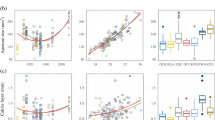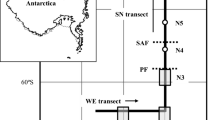Abstract
We studied variations in annual shell growth rates of ten live-collectedArctica islandica specimens from three localities at the Dogger Bank in the central North Sea. Synchronous growth curves from contemporaneous specimens enabled the construction of a 65-year multi-locality master chronology. Stepwise multiple linear correlation analysis indicated a highly significant (p<0.01) negative relationship between annual shell growth and winter sea surface temperatures (SST) during the period of 1953 to 1995. Up to 27.5% of the variation in the annual shell growth is explained by winter temperature. We explain the higher growrh levels in colder winters by higher food supply. During warmer winters both the stratification and bottom water currents in the study area seem to be stronger and prevent downward-mixing of nutrients as well as settlement of food on the sea floor. During colder winters, however, the stratification weakens and phytoplankton produced in the cold surface layer reaches the sea floor. Long-term changes in shell growth rates are thus directly connected to hydrographic changes in the North Sea, which in turn are relared to fluctuations of the North Atlantic Oscillation (NAO).
Our study demonstrates the usefulness ofArctica islandica for long-term, high-resolution environmental reconstructions and contributes to further understanding natural and anthropogenic variability in the environmental history of the North Sea.
Zusammenfassung
Die vorliegende Studie beschäftigt sich mit Variationen im jährlichen Schalenzuwachs von zehn lebend gefangenenArctica islandica Individuen von drei Lokalitäten auf der Doggerbank in der zentralen Nordsee. Aufgrund synchroner Verläufe der Wachstumskurven zeitgleich lebender Individuen konnten wir eine 65 Jahre umfassende Master-Chronologie erstellen. Schrittweise multiple lineare Korrelation indiziert einen hochsignifikanten (p<0.01) negativen Zusammenhang zwischen jährlichem Schalenzuwachs und Oberflächenwassertemperaturen (SST) während der Wintermonate über den Zeitraum von 1953 bis 1995. Bis zu 27,5% der Variation im jährlichen Zuwachs läßt sich durch Schwankungen der Wintertemperaturen erklären. Wir nehmen an, daß die höheren jährlichen Schalenzuwächse in kälteren Wintern mit höherem Nahrungsangebot zusammenhängen. Während wärmerer Winter scheint die vertikale Schichtung der Wassersäule im Nordosten der Doggerbank stärker zu sein. In Verbindung mit erhöhten Strömungen beeinträchtigt sie das Absinken des Phytoplanktons zum Meeresboden und verhindert ein Durchmischen von nährstoffreichen Oberflächenwassern und tieferen Wassermassen. Über längere Zeiträume sind die Nahrungsverfügbarkeit und damit das Schalenwachstum von Muscheln (hierArctica islandica) direkt an hydroklimatische Veränderungen gekoppelt, die in Verbindung mit der Variabilität der Nordatlantischen Oszillation (NAO) stehen.
Unsere Untersuchungen demonstrieren, daß sichArctica islandica für langzeitliche und hochauflösende Umweltrekonstruktionen eignet. Unsere Studie leistet darüber hinaus einen Beitrag zum besseren Verständnis natürlicher und anthropogener Variabilitäten der Umweltgeschichte der Nordsee.
Similar content being viewed by others
References
Ansell, A. D. (1968): The rate of growth of the hard clamMercenaria mercenaria (L) throughout the geographic range. — J. Cons, permanent internat. Explor. Mer,31: 364–409.
Becker, B. &Kroner, B. &Trimborn, P. (1991): A stable isotope tree-ring timescale of the Late Glacial/Holocene boundary. — Nature,353: 647–649.
Bradley, R. S. (1999): Paleoclimatology: Reconstructing Climates of the Quaternary. — 613 pp.; San Diego CA, London (Academic Press).
Briffa, K. R. &Bartholin, T. S. &Eckstein, D. &Jones, P. D. &Karlen, W. &Schweingruber, F. H. &Zetterberg, R. (1990): A 1,400-year tree-ring record of summer temperatures in Fennoscandia. — Nature,346: 434–439.
Briffa, K. R. &Jones, P. D. &Schweingruber, F. H. &Osborn, T. J. (1998): Influence of volcanic eruptions on Northern Hemisphere summer temperature over the past 600 years. — Nature,393: 450–455.
Brown, J. &Hill, A. E. &Fernand, L. &Horsburgh, K. J. (1999): Observations of a seasonal jet-like circulation at the central North Sea cold pool margin. — Estuar. Coast. Shelf Sci.,48: 343–355.
Cook, E. R. &Kairiukstis, L. A. [Eds.] (1990): Methods of Dendrochronology. Applications in the Environmental Sciences. — XII + 394 pp.; Dordrecht (Klüver).
Davenport, C. B. (1938): Growth lines in fossil pectens as indicators of past climates. — J. Paleont.,12: 514–515.
Ehrich, S. &Stransky, C. (2001): Spatial and temporal changes in the southern species component of North Sea bottom fish assemblages. — Senckenbergiana mark.,31: 143–150.
Feng, X. &Epstein, S. (1996): Climatic trends from isotopic records of tree rings: The past 100–200 years. — Climatic Change,33: 551–562.
Goodwin, D. H. &Flessa, K. W. &Dettman, D. L. &Schöne, B. R. (2001): Cross-calibration of daily growth increments, stable isotope variation, and temperature in the Gulf of California bivalve molluskChione cortezi: Implications for paleoenvironmental analysis. — Palaios,16: 387–398.
Grossman, E. L. &Ku, T.-L. (1986): Oxygen and carbon isotope fractionation in biogenic aragonite; temperature effects. — Chem. Geol., Isot. Geosci. Sect.,59: 59–74.
Hall, C. A. Jr. &Dollase, W. A. &Corbatö, C. E. (1974): Shell growth inTivela stultorum (Mawe, 1823) andCallista chione (Linnaeus, 1758) (Bivalvia): Annual periodicity, latitudinal differences, and diminution with age. — Palaeogeogr., Palaeoclimatol., Palaeoecol.,15: 33–61.
Henderson, J. T. (1929): Lethal temperatures of Lamellibranchiata. — Contr. Can. Biol. Fish.,4: 399–411.
Jones, D. S. (1980): Annual cycle of shell growth increment formation in two continental shelf bivalves and its paleoecologic significance. — Paleobiology,6: 331–340.
Jones, D. S. &Arthur, M. A. &Allard, D.J. (1989): Sclerochronological records of temperature and growth from shells ofMercenaria mercenaria from Narragansett Bay, Rhode Island. — Mar. Biol.,102: 225–234.
Jones, P. D. &Osborn, T.J. &Briffa, K. R (2001): The evolution of climate over the last millennium. — Science,292: 662–667.
Kennish, M.J. &Olsson, R. K. (1975): Effects of thermal discharges on the microstructural growth ofMercenaria mercenaria. — Environ. Geol.,1: 41–64.
Kröncke, I. &Dippner, J. W. &Heyen, H. &Zeiss, B. (1998): Long-term changes in the macrofauna communities off Norderney (East Frisia, Germany) in relation to climate variability. — Mar. Ecol. Prog. Ser.,167: 25–36.
Leuenberger, M. &Borella, S. &Stocker, T. &Saurer, M. &Siegwolf, R. &Schweingruber, F. &Matyssek, R. (1998): Stable isotopes in tree rings as climate and stress indicators. — Final sei. Rep. Nat. Res. Programme “Climate Changes and Natural Disasters”, NRP,31: 1–202; Zürich (vdf Hochschulverlag).
Marchitto, T. A. &Jones, G. A. &Goodfriend, G. A. &Weidman, C. R. (2000): Precise temporal correlation of Holocene mollusk shells using sclerochronology. — Quat. Res.,53: 236–246.
Otto, L. &Zimmermann, I. T. F. &Furnes, G. K. &Mork, M. &Saetre, R. &Becker, G. (1990): Review of the physical oceanography of the North Sea. — Netherl. J. Sea Res.,25: 161–238.
Reid, P. C. &Edwards, M. (2001): Long-term-changes in the pelagos, benthos and fishery of the North Sea. — Sencken-bergiana mark.,31: 107–115.
Robertson, I. &Switsur, V. R. &Carter, A. H. C. &Barker, A. C. &Waterhouse, J. S. &Briffa, K. R. &Jones, P. D. (1997): Signal strength and climate relationships in the13C/12C ratios of tree ring cellulose from oak in east England. — J. Geophys. Res.,102: 19507–19516.
Schöne, B. R. (2003): A ‘clam-ring’ master-chronology constructed from a short-lived bivalve mollusc from the northern Gulf of California, USA. — Holocene,13: 39–49.
Schöne, B. R. &Bentley, D. (2002): Use of HMDS (hexamethyl-disilazane) to dry organic microstructures in etched bivalve mollusk and barnacle shells. — Nautilus,116: 25–31.
Schöne, B. R. &Lega, J. &Flessa, K. W. &Goodwin, D. H. &Dettman, D. L. (2002): Reconstructing daily temperatures from growth rates of the intertidal bivalve molluskChione cortezi (northern Gulf of California, Mexico). — Palaeogeogr., Palaeoclimatol., Palaeoecol.,184: 131–146
Schöne, B. R. &Tanabe, K. &Dettman, D. L. &Sato, S. (in press): Environmental controls on shell growth rates and δ18O of the shallow-marine bivalve molluskPhacosoma japonicum in Japan. — Mar Biol.
Schweingruber, F. H. &Briffa, K. R. &Jones, P. D. (1991): Yearly maps of summer temperatures in Western Europe from A. D. 1750 to 1975 and Western North America from 1600 to 1972. — Vegetatio,92: 5–71.
Scuderi, L. A. (1993): A 2000-year tree ring record of annual temperatures in the Sierra Nevada Mountains. — Science,259: 1433–1436.
Svendsen, E. &Magnusson, A. K. (1992): Climatic variability in the North Sea. — ICES mar. Sci. Symp.,195: 144–158.
Vaganov, E. A. &Shiyatov, S. G. &Hantemirov, P. M. &Naurzbaev, M. M. (1998): The summer temperature variation in high latitudes of the northern hemisphere during last 1,5 thousand years: a comparative analysis of tree-ring data and ice cores. — Proc. Acad. Sci.,338: 681–684. — [in Russian].
Wieking, G. &Kröncke, I. (2001): Decadal changes in macrofaunal communities on the Dogger Bank caused by large-scale climate variability. — Senckenbergiana mark.,31: 125–141.
Wieking, G. &Kröncke, I. (2003a): Benthic communities of the Dogger Bank (central North Sea) in the late 90s: Spatial distribution, species composition and trophic structure. — Helgol. Mar. Res.,57: 34–46.
Wieking, G. &Kröncke, I. (2003b): Abundance and growth of the sea urchinEchinocardium cordatum in the central North Sea in the late 80s and 90s. — Senckenbergiana mark.,32 (1/2): 113–124.
Witbaard, R. (1996): Growth variations inArctica islandka L. (Mollusca): a reflection of hydrography-related food supply. — ICES J. mar. Sci.,53: 981–987.
Witbaard, R. (1997): Tree of the sea — The use of the internal growth lines in the shell ofArctica islandka (Bivalvia, Mollusca) for the retrospective assessment of marine environmental change. — Dissertation Thesis Univ. Groningen/NIOZ: 149 pp. Groningen (Rijksuniversiteit).
Witbaard, R. &Duineveld, G. C. A. &Wilde, P. A. W. J. de (1997): A long-term growth record derived fromArctica islandka (Mollusca, Bivalvia) from the Fladen Ground (northern North Sea). — J. Mar. Biol. Ass. U.K.,77: 801–816.
Author information
Authors and Affiliations
Corresponding author
Rights and permissions
About this article
Cite this article
Schöne, B.R., Kröncke, I., Houk, S.D. et al. The cornucopia of chilly winters: Ocean quahog (Arctica islandica L., Mollusca) master chronology reveals bottom water nutrient enrichment during colder winters (North Sea). Senckenbergiana maritima 32, 165–175 (2003). https://doi.org/10.1007/BF03043092
Received:
Revised:
Accepted:
Issue Date:
DOI: https://doi.org/10.1007/BF03043092




